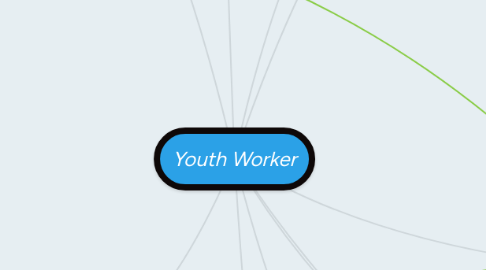
1. Code of Ethics
1.1. Core Values
1.1.1. Equity and Diversity
1.1.2. Democracy
1.1.3. Integrity
1.1.4. Wellbeing
1.1.5. Respect for others
1.2. Jeff, J & Smith M. K. (2005). Informal education conversations, democracy and learning. Nottingham: Education Heretics Press. Chapter 7, pp. 68-77
1.3. Confidentiality
1.3.1. Record keeping
1.3.2. Sharing of information
1.3.3. Respecting boundaries
1.3.4. Obligatory disclosures
1.3.4.1. Duty of care
1.3.4.2. Legally required
1.4. Boundaries
1.4.1. Withhold sensitive/compromising information
1.4.2. Limits may depend on context
1.4.3. Maintain professional position
1.4.4. Bessant, J., Watts, R., & Sercombe, H. (1998). Youth studies: an Australian perspective. South Melbourne, Vic: Longman. Chapter 15, pp. 229-240
2. Environments
2.1. Drop-in centres
2.2. Churches
2.3. Strret outreach
2.4. Shopping centres
2.5. Academic/learning environments
2.6. Counselling
2.7. Sports/recreation
2.8. Prisons
2.9. Community organisations
3. Models of intervention
3.1. Treatment
3.1.1. Society is arguably the primary constituent (?)
3.1.1.1. Conservative values
3.1.1.1.1. Stability/Sustainability
3.1.1.1.2. Tradition
3.1.2. Youth viewed as social problem
3.1.2.1. Expected to conform/change
3.1.2.2. Non-compliance seen as threat
3.1.2.3. Programs target problem-behaviour
3.1.3. Worker acts as positive role model
3.1.3.1. Demonstrate self-improvement skills
3.1.4. Worker knows better than young person
3.1.4.1. Naïve enquiry used less (?)
3.2. Reformed
3.2.1. Youth viewed as disadvantaged
3.2.1.1. By social environments
3.2.1.2. By upbringing
3.2.1.3. External factors make it hard to thrive
3.2.1.4. Need to be supported/saved
3.2.2. Worker seeks to help disadvantaged
3.2.2.1. Social inclusion
3.2.2.2. Equal opportunity
3.3. White, R., & Cooper, T. (1994). Models of youth work intervention. Youth Studies Australia, 13(4), 30-35.
3.4. Advocacy
3.4.1. Non-radical
3.4.1.1. Youth are unaware of their rights
3.4.1.1.1. Lack skills to play the system, receive benefits
3.4.1.1.2. Must realise rights to obtain them
3.4.1.1.3. Act on young person's behalf
3.4.1.2. Make it easier
3.4.1.2.1. For youth: Ensure means of opportunity
3.4.1.2.2. For worker: Network to assist with process
3.4.2. Radical
3.4.2.1. Society is unjust and must be changed
3.4.2.1.1. Youth are systematically marginalised
3.4.2.1.2. Expose the root cause
3.4.2.1.3. Social justice to be achieved for all
3.4.2.1.4. Fight for lasting change
3.4.2.2. Worker may represent group of young people
3.4.2.3. Campaigning
3.5. Empowerment
3.5.1. Non-radical
3.5.1.1. Youth lack power and control in their life
3.5.1.1.1. Support youth to make decisions for themself
3.5.1.1.2. Assist them on their course of action
3.5.2. Radical
3.5.2.1. Youth are systematically disempowered
3.5.2.1.1. Motivate youth to challenge society
3.5.2.1.2. Encourage self-representation
4. Youth work as a process
4.1. Assess
4.2. Engage
4.3. Question
4.4. Discern
4.5. Develop
5. Australian Youth Affairs Coalition (2013). The AYAC Definition of Youth Work in Australia. Retreived from: http://www.ayac.org.au/uploads/131219%20Youth%20Work%20Definition%20FINAL.pdf
6. Empowering practise
6.1. Independence
6.2. Realisation of rights
6.3. Social connectedness
6.4. Societal connectedness
6.5. Awareness of power relationship important
6.5.1. Work out/explain clearly
6.5.1.1. Policies
6.5.1.2. Boundaries
6.5.1.3. Role
6.5.1.4. Responsibilities
6.5.1.5. Expectations/duties
6.5.1.5.1. Worker
6.5.1.5.2. Client
6.5.1.6. Advantages and risks
6.5.2. Accountability skills taught
7. Relational practise
7.1. Work alongside young person in their context
7.2. Power relationship
8. Voluntary relationship
8.1. Enter into relationship willingly
9. Primary Constituent
9.1. Young people's interests are put first
10. Informal Education
10.1. Curriculum/Style
10.1.1. Creative process
10.1.2. Highly tailored to interests of learners
10.1.3. Indirect education style
10.1.4. Room for improvisation
10.1.5. Interactive
10.1.6. Engaging
10.1.7. Environmental learning
10.1.8. Shaped by precise set of values
10.2. Holistic approach
10.2.1. More than academic development
10.2.2. Caters to all aspects of personal development
10.3. Challenge
10.3.1. Behaviours/views
10.3.1.1. Assumptions about themselves
10.3.1.2. Assumptions about others
10.3.1.3. Assumptions about social environments
10.3.1.4. Assumptions about the world
10.3.2. Naïve enquiry
10.3.2.1. Non-assuming stance
10.3.3. Ask questions
10.3.4. Engage in conversation
10.4. Jeffs, T & Smith, M.K (2005) Informal Education: conversation, democracy and learning, revised edition Nottingham: Educational Heretics Press, Chapter 1, 4, 5, 6
10.5. Emancipate
10.5.1. Reflect
10.5.1.1. Return to experience
10.5.1.2. Attend to feelings
10.5.1.3. Evaluate experience
10.5.1.4. Both during and after
10.5.2. Work out own emotions
10.5.3. Learn from experience
10.5.4. Enlarge experience
10.5.5. Own experience (set it free)
10.6. Evaluate
10.6.1. Often conversational process
10.6.2. Quality of performance/actions
10.6.3. Targets, outcomes, efficiency
10.6.4. Efficiency perceived more often than measured
